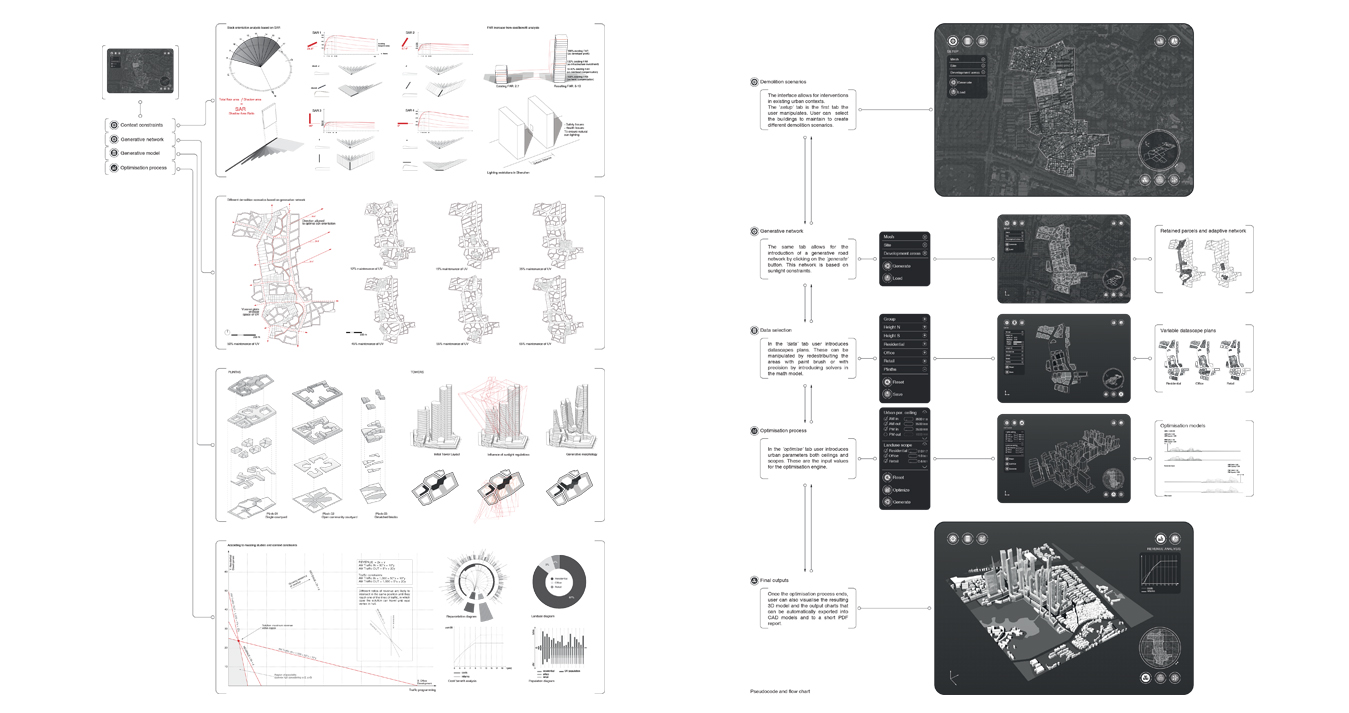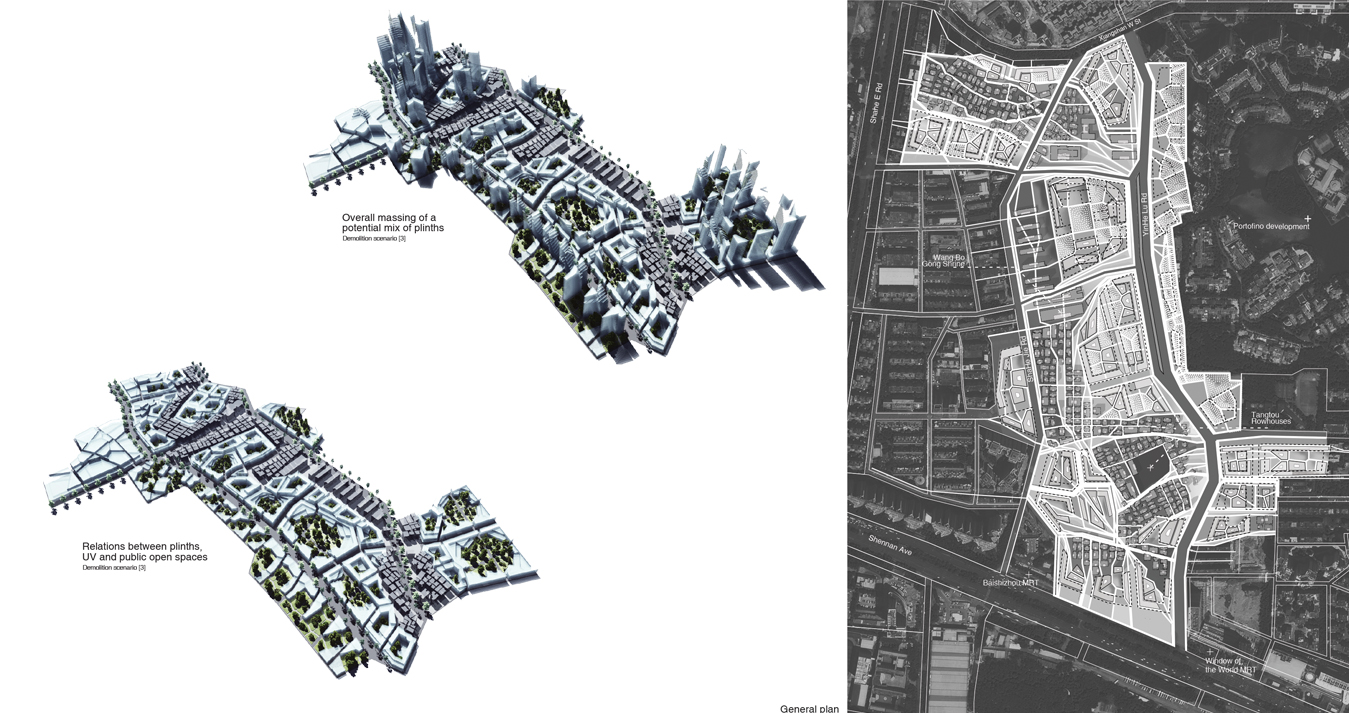Relational Urban Model: Baishizhou
In 2013 Arup DTF funding was granted for the study of the applicability of Relational Urban Models as new working methodologies in emerging economies. The funding is granted for the collaborative research between Arup, Relational Urbanism Ltd and ShenZhen University. The aim of the research was to aid and develop a new approach to Master-planning in emergent Economies based on the use of Relational Urban Models (RUM). The research shall prove that these models help the discussion and the allocation of development area (Gross Floor Area or GFA) in a master planning proposal according simultaneously to architectural concepts, infrastructure constraints and economic criteria.
A RUM is a digital design interface that generates 3D massing of urban environments derived from parameters (both mathematical and intuitive) as well as the representation of key infrastructure and environmental variables (traffic, CO2 emissions, built area). Its main advantages are:
•It is a dynamic tool that updates in real time a 3d model and the output data (traffic, cost, others) with the manipulation of the input variables.
•It is tailored to be understood by non-expert audience and to be used during negotiation workshops.
•The simultaneous visualization of design parameters and 3d massing allows for the discussion on how urban form is related to infrastructure requirements.
•It is a dynamic model that should enable the solution of complex negotiations running in simultaneously with the interface. This can help city governments and public institutions to develop strategies to incentivize private investment within city wide policy frameworks.
BaishiZhou is an urban village (UV) located in the centre of ShenZhen (SZ). While strategically located transport wise and surrounded by expensive real estate in SZ, the quality of the buildings is poor. This can have associated health and economic problems, since low quality urban fabric linked to ownership problems de-incentivise investment. There is a huge pressure from landowners and developers to evict the premises as most inhabitants are university students, low skilled workers employed in house service or low paid jobs in the area. The following objectives were set for the development of the RUM:
•To balance new fabric and old fabric achieving while maintaining social networks, urban character and existing economic activities.
-To provide social housing.
-To maximize real state revenue while observing sustainability objectives and minimising the impact on transport network both public and private.
- [FIRST PRIZE]
- [category] Research Project
- [institution] Arup, Relational Urbanism and Shenzhen University
- [year] 2013
- [leaders] Enriqueta Llabres and Eduardo Rico
- [team] Enriqueta Llabres, Giorgio Ponzo, Jung Hyun, Woo Juan, Carpio Javier Serrano, Giulia Grassi, Jung Hyun, Juan Carpio. Coding Direction: Immanuel Koh
Relational Urban Model: Baishizhou
In 2013 Arup DTF funding was granted for the study of the applicability of Relational Urban Models as new working methodologies in emerging economies. The funding is granted for the collaborative research between Arup, Relational Urbanism Ltd and ShenZhen University. The aim of the research was to aid and develop a new approach to Master-planning in emergent Economies based on the use of Relational Urban Models (RUM). The research shall prove that these models help the discussion and the allocation of development area (Gross Floor Area or GFA) in a master planning proposal according simultaneously to architectural concepts, infrastructure constraints and economic criteria.
A RUM is a digital design interface that generates 3D massing of urban environments derived from parameters (both mathematical and intuitive) as well as the representation of key infrastructure and environmental variables (traffic, CO2 emissions, built area). Its main advantages are:
•It is a dynamic tool that updates in real time a 3d model and the output data (traffic, cost, others) with the manipulation of the input variables.
•It is tailored to be understood by non-expert audience and to be used during negotiation workshops.
•The simultaneous visualization of design parameters and 3d massing allows for the discussion on how urban form is related to infrastructure requirements.
•It is a dynamic model that should enable the solution of complex negotiations running in simultaneously with the interface. This can help city governments and public institutions to develop strategies to incentivize private investment within city wide policy frameworks.
BaishiZhou is an urban village (UV) located in the centre of ShenZhen (SZ). While strategically located transport wise and surrounded by expensive real estate in SZ, the quality of the buildings is poor. This can have associated health and economic problems, since low quality urban fabric linked to ownership problems de-incentivise investment. There is a huge pressure from landowners and developers to evict the premises as most inhabitants are university students, low skilled workers employed in house service or low paid jobs in the area. The following objectives were set for the development of the RUM:
•To balance new fabric and old fabric achieving while maintaining social networks, urban character and existing economic activities.
-To provide social housing.
-To maximize real state revenue while observing sustainability objectives and minimising the impact on transport network both public and private.





















